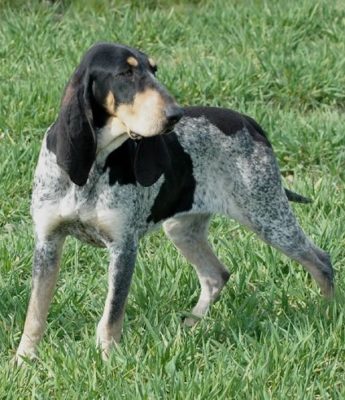Petit Bleu de Gascogne
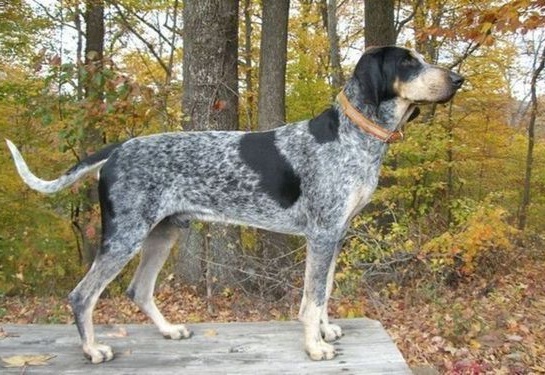
Proud, decisive, and self-confident is how Petit Bleu de Gascogne shows itself during the hunt. If you want to be sure that you will come back from the hunt with prey, spend your time with benefit, get many positive emotions, and then buy the Petit Bleu de Gascogne. Experienced hunters value the breed for its excellent nature, excellent sense of smell, and ability to work as a team.
Table of Contents
Breed Information
| Another Name | – |
| Origin | France |
| Height | Males 52-59 cm Females 50-55 cm |
| Weight | 17-23 kg |
| Fur | Short |
| Color | Black-feather (spotted) with a bluish tint and black (pale) spots |
| Lifespan | 12-14 years |
| FCI Classification | Scent hounds and related breeds |
| Group | Hunting dogs |
| Price | From $650 |
Breed Photos
Origin History
The origins of the Blue Gascon Hound go far back in time. In the fourteenth century, Count Gaston Febus brought the St. Hubert hounds to France’s south (the ancient historical region of Gascony). Here they were crossed with other hounds. Hence the name of the breed. It is now also accepted that the Blue Hound is a direct descendant of the Bloodhound.
The Petit Bleu de Gascogne is a copy of the Blue Gascon Hound, just slightly smaller. Hunters of that time complained about the Blue Gascon Hound’s slowness, so they decided to create a more agile and compact variety of the breed. The popularity of the breed immediately increased. The Petit Bleu de Gascogne attracted the attention not only of ordinary hunters but also the nobility. Henry IV used the dog in hunting deer and wild boar.
The first introduction of the Blue Gascon Hound as a separate breed occurred in 1863 in Paris. The breed was officially recognized by the Fédération Cynologique Internationale in 1920. And in 1925, a club of fans of the breed was created. Unfortunately, during the French Revolution, the Blue Hound was on the verge of extinction, and by 1974 there were only a few representatives of the breed. But in 1985, connoisseurs of the breed renewed the Petit Bleu de Gascogne (about 100 new individuals were registered by that time).
Appearance
The main difference between the Petit Bleu de Gascogne and its closest cousin is its more compact size. The height of the dogs is about 20 cm less than that of the big Gascon hound. The proud gait, attentive look, and courage are all accurate descriptions of the Petit Bleu de Gascogne. The head is large and long. Not too wide, but a convex skull. The transition from forehead to muzzle is faintly expressed. The lips are saggy. The eyes are dark in color and oval in shape. Curled floppy ears, thin and long. It reminds a cone shape, and its length reaches the neck. The neck is long. Convex ribs. The body is powerful; the dog looks slender and strong. Limbs with well-developed musculature. Tail saber shape.
The coat is short but very thick. It is called the Blue Hound because of its interesting color. Black symmetrical spots on a white background have a bluish cast, due to which it seems as if the dog is slightly blue. Spots all over the body can be completely different sizes. A white stripe separates the black spots on the head with a small black spot in the center – this is considered a feature of the breed.
Character
Proud, decisive, and self-confident is how Petit Bleu de Gascogne shows itself during the hunt. If you want to be sure that you will come back from the hunt with prey, spend your time with benefit, get many positive emotions, and then buy the Petit Bleu de Gascogne. Experienced hunters value the breed for its excellent nature, excellent sense of smell, and ability to work as a team. It will be devoted to its owner and find a common language with any family member, including children. Better suited to their own home than an apartment. However, if you can provide long walks with active exercises and games, the Petit Bleu de Gascogne can adapt to apartment life. Quite well developed and watchdog instinct. In case of an impending threat, the Blue Gascon will warn its owner with its endless ringing bark.
Care
The breed does not need any complicated special care. You only need to follow the standard hygienic recommendations. The only thing you should pay attention to more often is the pet’s ears. Because of their structure, extra moisture and dirt can accumulate in the ears, so clean them and monitor their condition several times a week. If you notice any abnormalities or inflammation, see your veterinarian immediately. Comb their coats a couple of times a week (shedding is not a heavy, seasonal activity). Bathe your pet as often as it gets dirty. Nails should be trimmed once a month.
Training
No matter how obedient the Petit Bleu de Gascogne may be, it is quite stubborn to learn and train. Here you will need to be persistent and accept the fact that quick training will not work. Don’t forget that their primary instinct is still hunting, agility and perseverance. You need to find a special approach that is based on trust and patience.
Common Diseases
The health of the Petit Bleu de Gascogne is quite strong. There are only a few diseases that are characteristic of the breed:
- hip dysplasia;
- deafness (occurs in the case of advanced ear inflammation).
Nutrition
In food, the Petit Bleu de Gascogne is unpretentious. The dog’s menu should be varied and balanced. The overall condition of the pet, its appearance, and normal formation depend on the diet. Therefore, the diet must contain protein and all the necessary vitamins. It is especially true during the change of season and the period of colds.
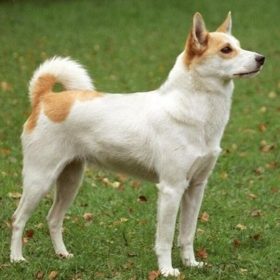 Norrbottenspets
Norrbottenspets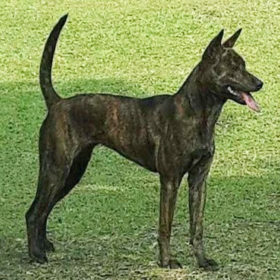 Taiwan Dog
Taiwan Dog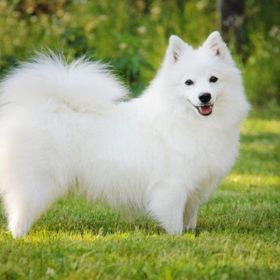 Japanese Spitz
Japanese Spitz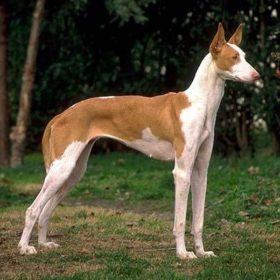 Ibizan Hound
Ibizan Hound Pharaoh Hound
Pharaoh Hound Istrian Short-haired Hound
Istrian Short-haired Hound